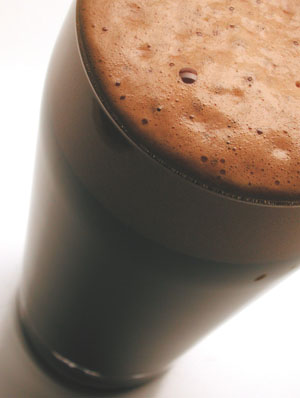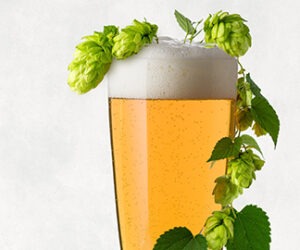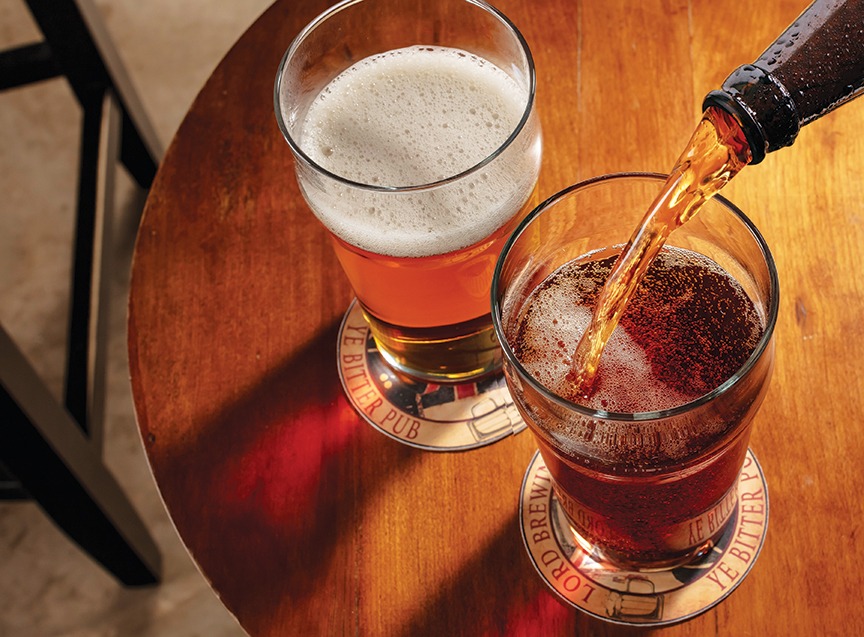Irish Dry Stout

Argh! I find it frustrating when people speak of all stouts as if they were the equivalent of used motor oil with enough alcohol to launch a rocket. Not all stouts are big and heavy and misconceptions keep a lot of people from trying some wonderful beers. While some stout substyles do have significant levels of alcohol and can be full-bodied, dry stout is usually a lower alcohol beer, with a dry finish and light body that makes it easy to consume. It is a great choice when you want to have a few flavorful beers without being overwhelmed by alcohol.
Dry stout is a very dark, roasty, bitter, and sometimes creamy ale. The commercial example most people know is Guinness Draught (4.1 to 4.3% ABV). It is a fine example of the style, right in the middle of the road as compared to some other commonly available dry stouts, such as Murphy’s (4 % ABV) and Beamish (4.1% ABV). Like all dry stouts, Guinness Draught is a fairly low gravity, low alcohol, and low body beer with a relatively high level of hop bittering. It is dry and bitter, but easy to drink by the pint because of its dryness, low alcohol and low carbonation.
Guinness starts with an aroma full of coffee and chocolate. The ester levels are fairly low, with some fruity/grape notes. The flavor is rich with coffee, chocolate, and a touch of pear/grape fruit esters. Overall, it is far more bitter than Murphy’s. The finish is sharp and dry with a long coffee and bittersweet chocolate finish.
Murphy’s is less roasty than Guinness and is sweeter. The aroma is much fruitier than either Guinness or Beamish, with apples and pears mixed in with moderate coffee notes. The flavor, like all good dry stouts, starts with coffee. It continues with a little bit of cocoa and more fruity esters.
Beamish is my favorite of the big three. It has a touch more acrid roast character than Guinness, almost to the point where it is biting. Guinness is less acrid, chocolatier. Beamish has minimal fruity esters, slightly more than Guinness, but less than Murphy’s. It also has something in the flavor and aroma that neither Guinness nor Murphy’s display — hops. The floral hop character is moderate and is obvious alongside the coffee, chocolate and slight fruitiness. While Beamish has more roast notes than Guinness and slightly more sweetness up front, in the end it has a drier finish.
Much has been made of Guinness sourness or Guinness “twang.” It is said that Guinness adds a portion of soured beer back to achieve that balance. To my palate, Beamish has as much “twang” as Guinness and reportedly they don’t add soured beer. I prefer to skip any sort of sour beer, sour wort, or acid malt addition. If you feel the beer you’re making needs something sour, you can experiment with those methods.
The roasted character of this style comes primarily from highly kilned, unmalted barley. There is conflicting information out there about the flavor difference between roasted malt and roasted barley, with some sources saying there is no difference and others saying that roasted malt provides more coffee-like character, but it is more acrid too. The difference is reportedly because the malted grain forms far more melanoidins when kilned. I’ve always been in the camp that believes there is a difference between the two, and when making a dry beer, it is best to avoid the more acrid roasted malt and use only roasted barley.
Optionally, a touch of a lighter roasted malt, such as chocolate (350–450 °L) can add a nice complexity to the roast character (more nutty/chocolate). The combination of dark malts in this style should add up to around 10% of the grist, give or take a couple points. While caramel malts are appropriate for some of the bigger stout styles, especially those with a sweeter finish, it is a mistake to include large amounts of caramel malt in a dry stout recipe. Caramel malts add non-fermentable sugar and caramel flavor, which negatively affect the dryness of the beer. If you’re trying to make a sweeter version, similar to Murphy’s, then perhaps a tiny bit of crystal malt is acceptable. You can also increase the perception of sweetness by reducing the amount of highly kilned grain, reducing hop bitterness, or by using a less attenuative yeast.
There is also some debate over the role of unmalted barley in dry stout, with one side saying it is important to the mouthfeel of the beer and the other saying it is used by the breweries for cost efficiency only. If you’re an all-grain brewer, it is simple enough to use flaked unmalted barley for a portion of your grist. If you’re an extract brewer, you can skip the flaked barley, otherwise you should convert it via a partial mash.
I prefer British pale ale malt as the base for dry stout. It provides a nice background biscuit-like malt character. British pale ale malt is kilned a bit darker (2.5 to 3.5 °L) than the average American two-row or pale malt (1.5 to 2.5 °L) and this higher level of kilning brings out the malt’s biscuity flavors. If you’re brewing with extract, your best choice is an extract made from British pale ale malt. Look for products labeled English pale, Maris Otter, or British-style malt extract.
Dry stout generally has a light body, some would say medium-light. Commercial breweries use all sorts of mash schedules, with the goal of converting the flaked barley and making a fermentable wort. You might hold the mash for a beta glucan rest, then a protein rest, and finally a saccharification rest when making a dry stout. I often combine the beta glucan rest and the protein rest at a temperature of 120 °F (49 °C) to simplify things. If you prefer a single infusion mash, a temperature around 150 °F (65 °C) strikes the proper balance between fermentable and non-fermentable sugars. I’ve read that Beamish uses a rest temperature of 143 °F (62 °C), so it seems that there is leeway for the saccharification rest. For extract brewers, most light colored extracts will get you fairly close. If not, you can make your extract-based wort more fermentable by replacing a portion of your extract with table or corn sugar or by doing a partial mash with some two-row malt and your extract.
Some brewers report various problems with the mash when making dry stout. One thing to keep an eye on is the mash pH as the dark grains can push the mash below 5.2 pH. If your water is low in alkalinity, you might need to tweak your water chemistry a bit to deal with the acidity of the dark malt. Adding a small amount of calcium carbonate and sodium bicarbonate to the mash to correct the pH is all it takes. Don’t try to replicate the water of Dublin or anything like that. In more locations than not, the water you have is fine for brewing dry stout.
Another common issue is the recirculation or runoff of the mash. Unmalted, flaked barley can be gummy (especially if you do not perform a beta glucan rest). To make matters worse, when a grain is highly kilned, it becomes brittle and when milled it produces a much higher percentage of flour and stuck mashes.
A good friend of mine believes in cold steeping his roasted malt. He adds the crushed malt to cold water the day prior and then adds the roasty liquor to the boil kettle as needed. He tells me that this method reduces any roasted grain harshness. Personally, I’ve not had a harshness issue, but this might be a useful tool in your arsenal if you wish to give it a try.
It is the highly kilned grain along with substantial hop bitterness that enhances the dry finish of this style. Target a bitterness-to-starting gravity ratio (IBU divided by OG) between 0.9 and 1.1. Normally, a single addition at 60 minutes is all you need. If you want a beer with some hop character, along the lines of Beamish, then a moderate later addition, say 1⁄2 ounce (14 g) around 20 minutes or later is appropriate. Hop choice for bittering and flavor is fairly flexible. Kent Goldings, Fuggle, Challenger, Target, Perle, Magnum all work well. Don’t use any citrusy or catty American-type hops.
Two great yeasts for brewing this style are White Labs WLP004 Irish Ale and Wyeast 1084 Irish Ale. Irish ale yeast provides the right low-ester profile but is only moderately attenuative. You’ll need to pitch the proper amount of clean, healthy yeast and keep a close eye on fermentation temperatures to ensure good attenuation. As an alternative, you can use a neutral ale yeast with higher attenuation, such as White Labs WLP001 California Ale, Wyeast 1056 American Ale or Fermentis Safale US-05 with acceptable results. For a more fruity interpretation, similar to Murphy’s, ferment warmer with the Irish ale yeast or switch to an English-style ale yeast. White Labs WLP007 Dry English or Wyeast 1098 British Ale work well. Some commercial breweries have been known to use lager yeasts for some stout styles. Whatever you use, pick a yeast that will finish dry enough for the style.
The final step in brewing a great example of this style is proper carbonation. Too much CO2 can make smaller beers seem thin and harsh. Carbonation of 1 to 1.5 volumes and a serving temperature of 52 to 55 °F (11 to 13 °C) is ideal. If you really want to go stout crazy, you can serve your dry stout with beer gas (a nitrogen/CO2 mix) on a stout faucet. (For more information about nitrogenating beer, read “The Nitrogen Effect,” in the May 1999 issue of BYO or “Achieving Nitro Nirvana” in the January-February 2005 issue.)
Guinness-Style Dry Stout
(5 gallons/19 L, all-grain)
OG = 1.041 (10.3°P)
FG = 1.010 (2.6°P)
IBU = 41 SRM = 44 ABV = 4.1%
Ingredients
6.25 lb. (2.83 kg) Crisp British pale ale malt or similar Maris Otter malt
1.75 lb. (794 g) Great Western flaked barley
14.0 oz. (397 g) Great Western roasted barley (500 °L) (crushed to powder)
8.35 AAU Kent Golding pellet hops (1.67 oz./47 g at 5% alpha acid) (60 min.)
White Labs WLP004 (Irish Ale), Wyeast 1084 (Irish Ale) or Fermentis Safale US-05 yeast
Step by Step
Crush the roasted barley very fine. Run it through a coffee mill or use a rolling pin to turn it almost to dust. That is critical to getting the right flavor and color with this recipe. Mill the remaining grains as normal and dough-in targeting a mash of around 1.5 quarts of water to 1 pound of grain (a liquor-to-grist ratio of about 3:1 by weight) and a temperature of 120 °F (49 °C). Hold the mash at 120 °F (49 °C) for 15 minutes then raise the temperature to 150 °F (66 °C) until enzymatic conversion is complete. Raise the temperature to mash out at 168 °F (76 °C). Sparge slowly with 170 °F (77 °C) water, collecting wort until the pre-boil kettle volume is around 6.5 gallons (24.4 L) and the gravity is 1.032 (8.1 °P).
The total wort boil time is 90 minutes. Add the bittering hops with 60 minutes remaining in the boil. Add Irish moss or other kettle finings with 15 minutes left in the boil. Chill the wort rapidly to 65 °F (18 °C), let the break material settle, rack to the fermenter, pitch the yeast and aerate.
Ferment at 65 °F (18 °C). Slowly raise the temperature during the final 1⁄3 of fermentation by 6 °F (3 °C) to reduce diacetyl levels in the beer. When finished, carbonate the beer to approximately 1 to 1.5 volumes and serve at 52 to 55 °F (11 to 13 °C).
Extract with Grains Option
Replace the British pale ale malt and flaked barley with 5.25 lb. (2.38 kg) Muntons pale ale liquid malt extract.
Partial Mash Option
The recipe becomes 1 lb. (0.45 kg) British pale ale malt, 1.75 lb. (794 g) flaked barley, 14 oz. (397 g) roasted barley, and 3.5 lb. (1.58 kg) Muntons pale ale liquid malt extract. Place the crushed grains and flaked barley in a steeping bag. Heat 5 quarts (~ 5 L) to 160 °F (71 °C), add grain bag, and let steep for approximately one hour. Rinse out the grains and proceed as normal, adding the extract and water to the steeping liquor.
Beamish-Style Dry Stout
(5 gallons/19 L, all-grain)
OG = 1.041 (10.2 °P)
FG = 1.009 (2.4 °P)
IBU = 40 SRM = 50 ABV = 4.1%
Ingredients
6.0 lb. (2.72 kg) Crisp British pale ale malt or similar malt made from Maris Otter
1.75 lb. (794 g) Great Western flaked barley
17.0 oz. (482 g) Great Western roasted barley (500 °L) (crushed)
7.6 AAU Challenger pellet hops (0.95 oz./27 g at 8% alpha acids)(60 min.)
2.5 AAU Kent Golding pellet hops (0.5 oz./14 g at 5% alpha acids) (15 min.)
White Labs WLP004 (Irish Ale), Wyeast 1084 (Irish Ale) or Fermentis Safale US-05 yeast
Step by Step
Crush the roasted barley very fine. Run it through a coffee mill or use a rolling pin to turn it almost to dust. That is critical to getting the right flavor and color with this recipe. Mill the remaining grains as normal and dough-in targeting a mash of around 1.5 quarts of water to 1 pound of grain (a liquor-to-grist ratio of about 3:1 by weight) and a temperature of 120 °F (49 °C). Hold the mash at 120 °F (49 °C) for 15 minutes then raise the temperature to 148 °F (64 °C) until enzymatic conversion is complete. Raise the temperature to mash out at 168 °F (76 °C). Sparge slowly with 170 °F (77 °C) water, collecting wort until the pre-boil kettle volume is around 6.5 gallons (24.4 L) and the gravity is 1.032 (8 °P).
The total wort boil time is 90 minutes. Add the bittering hops with 60 minutes remaining in the boil. Add Irish moss or other kettle finings and the last hop addition with 15 minutes left in the boil. Chill the wort rapidly to 69 °F (21 °C), let the break material settle, rack to the fermenter, pitch the yeast and aerate thoroughly.
Ferment at 69 °F (21 °C). Slowly raise the temperature during the final 1⁄3 of fermentation by 6 °F (3 °C) to reduce diacetyl levels in the beer. When finished, carbonate the beer to approximately 1 to 1.5 volumes and serve at 52 to 55 °F (11 to 13 °C).
Murphy’s-Style Dry Stout
(5 gallons/19 L, all-grain)
OG = 1.040 (10 °P)
FG = 1.010 (2.5 °P)
IBU = 38 SRM = 33 ABV = 4%
Ingredients
6.0 lb. (2.72 kg) British pale ale malt
1.75 lb. (794 g) flaked barley
14.0 oz. (397 g) roasted barley (500 °L)
7.75AAU Kent Golding pellet hops (1.55 oz./44 g at 5% alpha acids) (60 min.)
White Labs WLP007 (Dry English), Wyeast 1098 (British Ale) or Danstar Nottingham yeast
Step by Step
I use Crisp Malting’s British Pale Ale malt (made from Maris Otter) as my base grain, but other malts of a similar nature should work well. The roasted barley and flaked barley I use is from Great Western Malting Co. Feel free to substitute any high quality product of a similar flavor and color from a different supplier. My hops are in pellet form and come from Hopunion.
In this recipe the roasted barley is milled normally along with the other grains. Dough-in targeting a mash of around 1.5 quarts of water to 1 pound of grain (a liquor-to-grist ratio of about 3:1 by weight) and a temperature of 152 °F (67 °C). Hold the mash at 152 °F (67 °C) until enzymatic conversion is complete. Infuse the mash with near boiling water while stirring or with a recirculating mash system raise the temperature to mash out at 168 °F (76 °C). Sparge slowly with 170 °F (77 °C) water, collecting wort until the pre-boil kettle volume is around 6.5 gallons (24.4 L) and the gravity is 1.031 (7.8 °P).
The total wort boil time is 90 minutes. Add the bittering hops with 60 minutes remaining in the boil. Add Irish moss or other kettle finings with 15 minutes left in the boil. Chill the wort rapidly to 69 °F (21 °C), let the break material settle, rack to the fermenter, pitch the yeast and aerate thoroughly.
Ferment at 69 °F (21 °C). Slowly raise the temperature during the final 1⁄3 of fermentation by 6 °F (3 °C) to reduce diacetyl levels in the beer. When finished, carbonate the beer to approximately 1 to 1.5 volumes and serve at 52 to 55 °F (11 to 13 °C).



